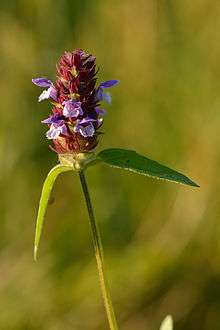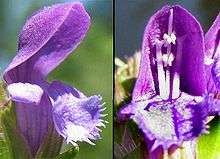Prunella vulgaris
| Prunella vulgaris | |
|---|---|
 | |
| Scientific classification | |
| Kingdom: | Plantae |
| (unranked): | Angiosperms |
| (unranked): | Eudicots |
| (unranked): | Asterids |
| Order: | Lamiales |
| Family: | Lamiaceae |
| Genus: | Prunella |
| Species: | P. vulgaris |
| Binomial name | |
| Prunella vulgaris L. | |
Prunella vulgaris (known as common self-heal or heal-all)[1] is an herbaceous plant in the genus Prunella.
Self-heal is edible: the young leaves and stems can be eaten raw in salads; the plant in whole can be boiled and eaten as a potherb; and the aerial parts of the plant can be powdered and brewed in a cold infusion to make a beverage.
Description

Prunella vulgaris grows 5 to 30 cm high[2] (2-12inches), with creeping, self-rooting, tough, square, reddish stems branching at leaf axis.[3]
The leaves are lance shaped, serrated, and reddish at tip, about 2.5 cm (1 inch) long and 1.5 cm (half an inch) broad, and growing in opposite pairs down the square stem.[3] Each leaf has 3-7 veins that shoot off of the middle vein to the margin. The stalks of the leaves are generally short, but can be up to 5 cm (2 inches) long.[4]
The flowers grow from a clublike, somewhat square, whirled cluster; immediately below this club are a pair of stalkless leaves standing out on either side like a collar. Flowers are two lipped and tubular. The top lip is a purple hood, and the bottom lip is often white; it has three lobes with the middle lobe being larger and fringed upwardly. Flowers bloom at different times depending on climate and other conditions, but mostly in summer (from June to August in the USA).[3]
Self-heal propagates both by seed and vegetatively by creeping stems that root at the nodes.[5]
Range and habitat
Heal-all is a perennial herb found throughout Europe, Asia and North America, as well as most temperate climates. Its origin seems to be European , though it has been documented in other countries since before any history of travel . In the Republic of Ireland it is currently abundant in the west in the counties Galway and Clare, the southwest in Kerry, the south coast, and is also found around the central basin of Ireland . It is often found growing in moist areas, waste ground, grassland, woodland edges, and usually in basic and neutral soils.[3][6]
Edibility
Heal-all is edible, and can be used in salads, soups, stews, and boiled as a pot herb. The Cherokee cooked and ate the young leaves. The Nlaka'pamux drank a cold infusion of the whole plant as a common beverage.[7] The plant contains vitamins A, C, and K, as well as flavonoids and rutin.[8]
Folk medicine
Topically, a poultice of the plant is applied to irritated skin, as a disinfecting agent and to pack wounds in the absence of other wound-care material.[9] It was considered by the Chinese to "change the course of a chronic disease".[7]
Chemistry
The plant's chemical constituents include betulinic acid, D-camphor, D-fenchone, cyanidin, delphinidin, hyperoside, manganese, lauric acid, oleanolic acid, rosmarinic acid, myristic acid, rutin, linoleic acid, ursolic acid, beta-sitosterol, lupeol, and tannins.[8][10][11][12]
References
| Wikimedia Commons has media related to Prunella vulgaris. |
| Wikispecies has information related to: Prunella vulgaris |
- ↑ Other names include Lance Selfheal, Aleutian selfheal, Heal-all, Carpenter weed, Heart-of-the-earth, Blue Curls (generically) and Hook Heal. In Germany it is known as Kleine Braunelle; In Finland it is called Niittyhumala, and in Poland it is Glowienka pospolita.
- ↑ Clapham, A.R., Tutin, T.G. and Warburg, E.F. 1968. Excursion Flora of the British Isles. Cambridge University Press. ISBN 0-521-04656-4
- 1 2 3 4 "Conservation Plant Characteristics for Prunella vulgaris L. (common selfheal)". Plants Database. United States Department of Agriculture.
- ↑ Duke, James (2001). "Prunella vulgaris". Handbook of Edible Weeds. CRC. p. 158. ISBN 978-0-8493-2946-3.
- ↑ DiTomaso, Joseph M.; Healy, Evelyn A. (2007). Weeds of California and Other Western States, Volume 1. ANR. p. 884. ISBN 978-1-879906-69-3.
- ↑ Foster, Steven; Hobbs, Christopher (2002). "Self-heal, Heal-All". A Field Guide to Western Medicinal Plants and Herbs. Houghton Mifflin Harcourt. p. 231. ISBN 978-0-395-83806-8.
- 1 2 Meuninck, Jim (2008). Medicinal Plants of North America: A Field Guide. Globe Pequot. p. 41. ISBN 978-0-7627-4298-1.
- 1 2 Khare, C.P. (2007). Indian Medicinal Plants: An Illustrated Dictionary. Springer. p. 103. ISBN 978-0-387-70637-5.
- ↑ Ryu SY, Oak MH, Yoon SK, et al. (May 2000). "Anti-allergic and anti-inflammatory triterpenes from the herb of Prunella vulgaris". Planta Med. 66 (4): 358–60. doi:10.1055/s-2000-8531. PMID 10865455.
- ↑ Harrewijn, Paul; et al. (2001). Natural Terpenoids As Messengers: A Multidisciplinary Study of Their Production, Biological Functions, and Practical Applications. Springer. p. 347. ISBN 978-0-7923-6891-5.
- ↑ Duke, James A.; Beckstrom-Sternberg, Stephen M. (2001). Handbook of Medicinal Mints (Aromathematics): Phytochemicals and Biological Activities. CRC. p. 222. ISBN 978-0-8493-2724-7.
- ↑ Hoffman, Edward J. (1999). Cancer and the Search for Selective Biochemical Inhibitors. CRC. p. 472. ISBN 978-0-8493-9118-7.